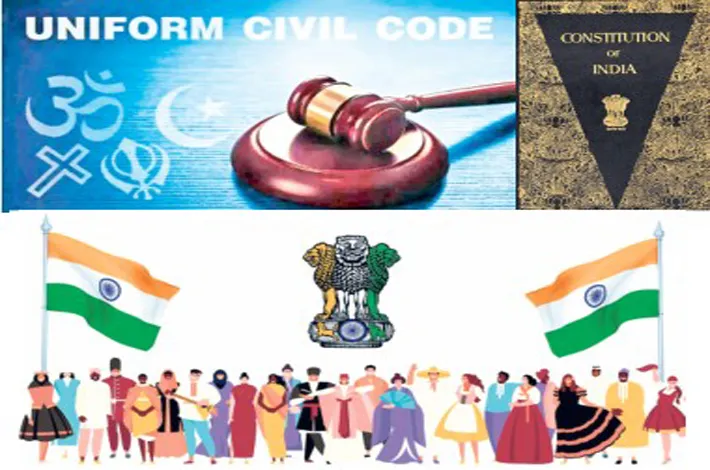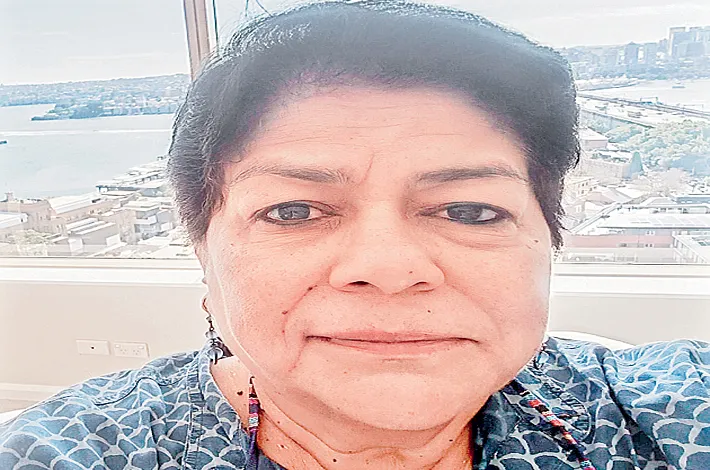Uniform Civil Code: A constitutional dream, political PUZZLE
03-11-2025 12:00:00 AM

In 2024, Uttarakhand became the first state to enact a UCC, banning polygamy, standardizing marriage age, mandating registration and equalizing inheritance. Goa, inheriting the Portuguese Civil Code of 1867, has lived with a version of UCC for over a century
The phrase “Uniform Civil Code” (UCC) has been a commonly one heard across India’s courtrooms, parliaments and television studios for nearly eight decades, yet it remains one of the most unreached goals of the Indian Republic. At its simplest, the UCC proposes a single, secular legal framework to govern personal matters—marriage, divorce, inheritance, adoption, and maintenance—for every citizen, irrespective of religion, caste, or community. It is not a call to erase faith but to remove faith-based disparities from civil law. In a nation of 1.4 billion people and a large packet of diverse practices, the idea is both visionary and volatile.
Article 44 of the Indian Constitution, which is included in the non-justiciable (matters on which court having no juridistiction) “Directive Principles of State Policy”, captures the intended result in a single sentence: “The State shall endeavor to secure for the citizens a uniform civil code throughout the territory of India.” Drafted in 1949, the clause was quiet contrary to the colonial legacy of separate personal laws and a nod to the secular and equitable republic the framers imagined.
Dr. B.R. Ambedkar, chairman of the Drafting Committee, saw personal laws as a medieval shackle; Jawaharlal Nehru viewed UCC as a modernizing force; but Rajendra Prasad and others feared it would fracture a newly independent nation still healing from Partition. At the same time, the Constitution grants freedom of religion under Articles 25–28 and cultural/educational rights under Articles 29–30. Any push for UCC must engage as well as balance with the contradiction between these rights and the directive under Article 44
Currently, India follows a system of personal laws based on religious scriptures and customs: Hindus, Buddhists, Jains, and Sikhs- Hindu Marriage Act, Hindu Succession Act, etc; Muslims - Muslim Personal Law (Shariat) Application Act, 1937;Christians -Indian Christian Marriage Act, 1872 and Indian Divorce Act, 1869; Parsis - Parsi Marriage and Divorce Act, 1936. These laws differ significantly—especially in areas like polygamy, divorce procedures, inheritance shares, and adoption rights.
The compromise: make it a goal, not a mandate.
The journey of the UCC is best understood through the viewpoint of landmark judicial interventions and political flip-flops. The first tremor came in 1985 with the Shah Bano case. A 62-year-old divorced Muslim mother of five demanded maintenance beyond the Islamic iddat(cooling) period. The Supreme Court, led by Chief Justice Y.V. Chandrachud, ruled in her favor under Section 125 of the Criminal Procedure Code—a secular provision—and lamented the absence of a UCC. “A common civil code will help the cause of national integration by removing disparate loyalties to laws which have conflicting ideologies,” the bench observed. Ultra orthodox and ultra conservative groups erupted, rallied and in 1986, Rajiv Gandhi’s government passed the Muslim Women (Protection of Rights on Divorce) Act, effectively nullifying the verdict. The episode exposed the fragility of judicial victories when confronted with vote-bank politics.
A decade later, in the Sarla Mudgal case (1995), the Supreme Court revisited the issue. A man converted this religion to marry a second time without divorcing his first wife. The Court ruled the conversion fraudulent and reiterated the need for UCC to prevent such “legal subterfuge.” In 2003, the John Vallamattom case struck down a discriminatory Christian inheritance law and again urged Parliament to act.
The Shayara Bano judgment of 2017, which declared instant triple talaq unconstitutional, was celebrated as a partial victory for UCC principles, yet it also underscored the non permanent and “for the time being” nature of reform—addressing one practice while leaving dozens untouched. Politically, the UCC has been a pendulum. The Bharatiya Janata Party (BJP) first included it in its 1998 manifesto; Narendra Modi’s governments have repeatedly promised a national law.
In 2024, Uttarakhand became the first state to enact a UCC, banning polygamy, standardizing marriage age, mandating registration and equalizing inheritance. Goa, inheriting the Portuguese Civil Code of 1867, has lived with a version of UCC for over a century—bigamy is illegal, daughters inherit equally and divorce is mutual. Assam and Gujarat are drafting their own versions. Yet, at the Centre, the 22nd Law Commission in 2018 deemed UCC “neither necessary nor desirable at this stage,” advocating instead for incremental reform within personal laws.
Proponents of the UCC frame it as a constitutional imperative and a gender justice milestone. They argue that personal laws perpetuate inequality: Muslim men may marry four times; Hindu daughters, until 2005, had limited coparcenary rights(legal rights to inherit a share in an ancestral property by birth, typically within a Hindu Undivided Family (HUF)); Christian women face cumbersome divorce procedures; Parsi widows lose community rights upon remarriage.
A single code, they say, would level the field. It would also simplify the legal system—judges would no longer juggle conflicting statutes—and reinforce secularism by treating citizens as individuals, not members of religious collectives. National integration, administrative efficiency and alignment with global human rights norms are frequently cited. As a senior Supreme Court advocate argued in a recent television debate, “There are two laws in India—one for non-Hindus, one against Hindus. UCC is a prerequisite for India’s unity.”
Opponents, however, see the UCC as an indirect and masked method for imposing the practices of majority and politically powerful sections on others. Muslim organizations like the All India Muslim Personal Law Board (AIMPLB) contend that Sharia-derived laws are divinely ordained and protected under Article 25’s guarantee of religious freedom. They fear a Hindu-coded UCC would erase minority identity. Practical concerns abound: how does one reconcile Islamic inheritance (sons get double daughters’ share) with absolute equality? Would tribal customary laws in the Northeast be overridden? Critics also point to selective outrage—why target Muslim polygamy when Hindu bigamy persisted until 1955, and serial monogamy remains common across communities?
The 1986 reversal of Shah Bano is invoked as proof that UCC rhetoric masks political expediency. Within the Muslim community, viewpoints splinter. Reformist voices like Suboohi Khan, National Convener of Rashtra Jagrukta Abhiyan, insist reform must come from within. “Triple talaq is banned, but talaq-e-hasan, misyar nikah, and child marriages continue. We violate POCSO in the name of personal law. This isn’t civil—it’s criminal.” she declared in a TV debate. Islamic Scholar Atiq ur Rahman acknowledges tensions between liberal and orthodox interpretations of Islam but cautions against state overreach. At the same time there also strong voices on the other sides. Clerics like Advocate Tala Rashadi and Rashid Sharif dismiss UCC as propaganda, questioning the faith of reformist Muslims and warning of cultural erasure.
Feminist scholars offer nuanced critiques. Some welcome UCC as a blow to male domination across religions; others worry it may impose a template of socially and politically dominant communities, ignoring matrilineal traditions among Nair Hindus or Khasis. Dalit and Adivasi activists fear their customary laws—often more gender sensitive and promoting equality—could be overruled. Legal experts highlight drafting challenges: a UCC must balance equality with reasonable classification, navigate federalism (personal laws are in the Concurrent List) and withstand judicial scrutiny under Articles 14 and 15.
A soon to be released hindi film “Haq”, inspired by Shah Bano and directed by Suparn Verma, has reignited the debate. Its trailer promises a narrative of dignity over dogma. During a televised debate, Verma defended the project saying that the film is not an attack on any faith but is about an Indian Muslim woman fighting for her rights. Yet panelists clashed fiercely. A member of the waqf board of one of the states accused the film of targeting Muslim women; Suboohi Khan countered that resisting reform perpetuates injustice.
Public opinion remains polarized.
A 2023 survey found 54% support for UCC, with higher backing among urban, educated and younger respondents. Yet support drops among Muslims (36%) and Christians (41%). Regional variations are stark—Goa accepts its existing code; Uttarakhand’s law faced protests from tribal groups exempt under Article 371.Internationally, India is somewhat different and socially apart from others. Most secular democracies—France, Germany, Turkey—have uniform civil codes. Turkey’s 1926 code, inspired by Switzerland, abolished polygamy and equalized inheritance. Indonesia, the world’s largest Muslim-majority nation, applies a mix but mandates civil registration. Even Saudi Arabia, while retaining Sharia courts, has codified family law procedures.
India’s hesitation seems to come from its colonial inheritance: the British codified Hindu and Muslim laws to govern without offending natives, strengthening communal segregation.The path forward is fraught. A national UCC requires political consensus, judicial backing, and cultural sensitivity. Incremental steps—mandatory marriage registration, compulsory civil ceremonies, gender-neutral succession—could build trust. The Law Commission’s 2018 consultation paper suggested codifying “just” elements of each personal law rather than imposing a monolithic code.
The way forward:
From the academic/legal commentary, the way forward for UCC is often proposed in phases and with safeguards. First, to engage broad consultation with all religious, community and tribal groups to build consensus rather than impose top-down reforms. The UCC framework needs to respect essential religious practices but target reform of civil matters, ensuring the code focuses on areas like marriage, divorce, succession, guardianship etc where inequalities are evident.
The government needs to ensure the UCC is gender-sensitive, rights-based and secular in character, not favoring one religion’s customs over another’s. There is also a need to develop the administrative infrastructure: legal registration systems (marriage, divorce, adoption, inheritance), awareness campaigns, access to justice for marginalized communities. Also, the legislative process needs to allow for state-wise adaptability because India’s states and regions vary widely; the UCC needs to be introduced gradually, via state-wise pilots (as is already happening).
Uttarakhand’s law exempts Scheduled Tribes, registers live-in relationships and bans polygamy—a pragmatic middle ground. Ultimately, the UCC is less about law than about identity. It asks whether India’s diversity is a mosaic to be preserved or a barrier to be transcended. Shah Bano’s fight, Haq’s narrative, and Suboohi Khan’s defiance remind us that the battle is not between religions but between equality and exception. As Justice Chandrachud wrote in 1985, “The controversy is not a storm in a teacup. It is a symptom of a deeper malaise.” Forty years later, the problem persists, but so does the dream. The Uniform Civil Code is not a destination but a dialogue—one that India must have, not in shouts across television studios, but in the quiet conviction that a woman’s right to dignity should not depend on the faith she was born into. Until then, Article 44 will remain what it has always been: a promise and a provocation.









